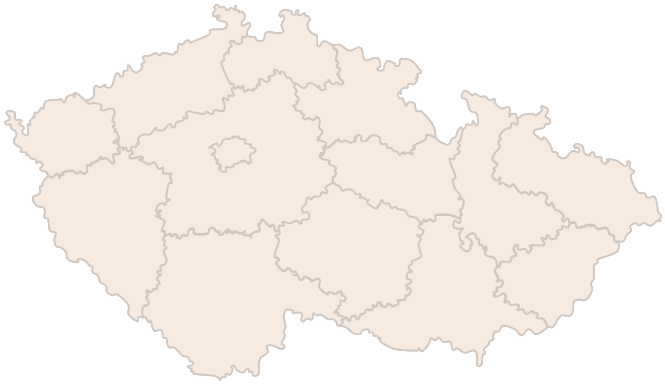In this article, we will explain what VAT is, how input and output VAT works, what the deadlines and obligations are in 2025 and add specific examples of VAT accounting.
What is VAT and what are the rates in 2025
VAT is an indirect tax imposed on most goods and services. The tax is effectively borne by the final consumer, collected by taxpayers in the price and then remitted to the state. Two VAT rates apply in the Czech Republic in 2025 : 21% (standard) and 12% (reduced). The standard rate applies to all supplies not explicitly included in the reduced rate. If you are unsure about the rate for a particular supply, you can ask the General Financial Directorate for a binding assessment of the rate.
What does this mean in practice? You add 21% or 12% to the invoice price excluding VAT depending on the type of supply; for exempt supplies (e.g. selected financial services) you do not charge VAT.
Tip for article
We have discussedVAT rates in detail in another article.
When you become a VAT payer
From 1 January 2025, new rules apply for compulsory VAT registration. Turnover is now assessed per calendar year (1 January-31 December) and the law works with two thresholds: CZK 2,000,000 and CZK 2,536,500.
If your turnover exceeds CZK 2,000,000, you will become a taxpayer from 1 January of the following year, unless you notify in a timely filed application that you want to become a taxpayer earlier. If you exceed the higher threshold of CZK 2 536 500 during the same year, you become a taxable person from the day after the date of the excess. You must then submit your application within 10 working days of exceeding the relevant threshold.
These changes can also practically affect the year-end revenue planning (e.g. timing of large orders).
Identified Person (IO)
If you are not a taxpayer but trade across EU borders (e.g. you purchase goods from the EU or provide selected services to customers in the EU), you may be required to register as a taxable person. The IO acts as a taxpayer abroad, but remains a non-taxpayer in the Czech Republic and is not entitled to deduct input VAT. It only declares and pays VAT on the cross-border transactions concerned and often files a summary report.
Frequently Asked Questions
Can I volunteer early?
Yes – voluntary registration is possible and is particularly useful if you are doing B2B business. The application is made via MY Taxes.
What if we cross the threshold at the end of the year (e.g. 28 December)?
If you exceed CZK 2,000,000 in December, you are a taxpayer from 1 January of the following year. If you exceed CZK 2,536,500 on 28 December, you are already a taxpayer from 29 December of the same year.
Can we become an IO by accepting an advance from the EU?
Yes. From 2025 onwards, you become an IO on the date of receipt of the consideration (if the transaction is sufficiently certain) and you are also obliged to submit a summary report for that month.
Does the identified person submit an audit report?
No. The IO submits VAT returns only for the months concerned and a summary report. The control report does not concern it at all.
Input and output VAT
Output VAT is the tax you charge to your customers when you sell goods or services and you are obliged to pay it to the state. Input VAT is the tax on the invoices you receive and you are entitled to deduct it if you use the supplies you receive for your taxable transactions (typically for your business).
The result for the period is the difference: if the output is higher than the input, you pay VAT; if the input is higher, you incur an excess deduction of VAT. This mechanism is at the heart of how VAT works.
Reverse charge
For selected domestic supplies (e.g. specific commodities or construction work), the reverse charge regime may apply – VAT is not declared and paid by the supplier, but by the customer.
Are you solving a similar problem?
Not sure how to do your taxes properly so you don't get it wrong?
We can help you navigate the law, whether it’s dealing with a specific tax situation, preparing for an audit by the tax authority or defending yourself in court.
I want to consult
- When you order, you know what you will get and how much it will cost.
- We handle everything online or in person at one of our 6 offices.
- We handle 8 out of 10 requests within 2 working days.
- We have specialists for every field of law.
How to account for VAT: basic information
In Czech double-entry bookkeeping, VAT is accounted for in account 343 – Value Added Tax. In the Má dáti (MD) account 343 you record input VAT ( entitlement to deduction), in the Dal account 343 output VAT ( obligation to pay). The balance of account 343 after the end of the period represents either a claim on the State (excess deduction) or a liability to the State (tax to be paid).
Difference in accounting for non-taxable and taxable VAT
Non-payer of VAT
A non-taxpayer does not charge output VAT, is not entitled to deduct VAT and does not use account 343 – Value added tax in normal domestic transactions. The VAT paid by the non-taxpayer on receipts from taxpayers becomes part of the cost or purchase price of the asset (e.g. materials, goods, fixed assets). The non-taxpayer does not submit a VAT return or control declaration – the exception is when he becomes an identified person for cross-border transactions.
VAT payer
The taxable person accounts for output VAT (on sales) and applies input VAT ( on taxable supplies received) in account 343; the result is either a tax liability to be paid or an excess deduction. The taxable person submits the VAT return and control report by the 25th day after the end of the tax period (month/quarter).
Tip for article
What are the obligations of VAT payers and non-payers and which is more profitable for you? This is what our article will tell you.
Identified person
An identified person files a VAT return only for the period in which the obligation to declare the tax arose (e.g. in the month in which the person received an advertisement from abroad). If he or she provides a service with a place of supply in another Member State (typically under the general B2B rule), he or she also files a summary return – always by the 25th day after the end of the relevant month. Filing is done electronically.
Foreign documents must also be converted for VAT purposes at the CNB exchange rate applicable on the date of the tax liability (typically the date of the taxable supply).
The IO is not entitled to a deduction, therefore the VAT assessed is its expense. In the accounting system, the tax is recorded in account 343 and at the same time reflected in the cost or purchase price by an internal document.
Beware of the limit for acquisitions of goods from the EU: as long as the sum of the acquisitions does not exceed CZK 326,000 (in the current or immediately preceding year), the acquisition is not taxable in the Czech Republic and IO will not arise by law. Once the limit is exceeded, the first subsequent acquisition becomes an IO and you will be liable for Czech VAT.
VAT accounting – examples
1) VAT payer – normal operation
a) Purchase of office supplies (10 000 + 2 100 VAT)
- The invoice received is booked as follows: you put 10 000 (amount excluding VAT) in cost account 501, 2 100 in account 343 (input VAT – claim) and 12 100 in total to the supplier in liability account 321.
(b) Sale of goods (50 000 + 10 500 VAT)
- You enter the invoice issued as a receivable from 311 in the amount of 60 500. Of this, 50 000 is revenue in account 604 and 10 500 is output VAT in account 343 (liability to the State).
(c) VAT closing for the period
- If the output VAT is higher than the input VAT (e.g. 10 500 – 2 100 = 8 400), send 8 400 to the tax office.
- If, on the other hand, the input is more than the output, you will incur an excess deduction.
Balance account 343 at the end of the period and pay the VAT to the tax office
Let’s imagine that for a month you have output VAT of CZK 31 500 and input VAT of CZK 21 000. The resulting tax to be paid is CZK 10 500.
If you have input VAT of CZK 40 000 and output VAT of CZK 31 500, the difference of CZK 8 500 is an over-deduction – a debt to the state. After filing your return, the tax office will refund the amount (or apply it to other tax arrears).
Domestic reverse charge (transfer of tax liability)
If you supply construction work to a taxpayer, the supply falls under the reverse charge regime. You issue an invoice without VAT with the words “thecustomer pays the tax“. The customer will declare the output VAT and claim the input deduction at the same time.
Advances, credit notes and corrections to the tax base
For advances received, VAT is declared at the time of receipt of payment; the final invoice then credits the advance. For a credit note (corrective tax document), the statutory rules apply – you issue a corrective tax document and make a correction in the return and in the control report for the period when the conditions for the correction occurred (e.g. recognition of a claim). This correction is itself a taxable supply.
Are you solving a similar problem?
Not sure how to do your taxes properly so you don't get it wrong?
We can help you navigate the law, whether it’s dealing with a specific tax situation, preparing for an audit by the tax authority or defending yourself in court.
I want to consult
- When you order, you know what you will get and how much it will cost.
- We handle everything online or in person at one of our 6 offices.
- We handle 8 out of 10 requests within 2 working days.
- We have specialists for every field of law.
2) VAT non-payer – normal domestic operations
a) Purchase of goods (10 000 + 2 100 VAT)
- The whole 12,100 is an expense or the cost of the asset for you as you do not claim VAT. So you record an expense (e.g. 501) of 12 100 and a liability of 321 12 100.
(b) Sale of a service for 15 000
- There is no VAT on the invoice. You record a receivable 311 and a revenue 602, both 15 000.
3) Identified person (IO) – service received from the EU (reverse charge)
Example: a non-taxpayer receives an invoice from Google Ireland in May for an advertisement of EUR 500. For VAT purposes, he converts at the CNB rate on the date of supply, say 25.00 → base CZK 12,500, Czech VAT CZK 2,625.
- You enter the invoice received as a cost of service (e.g. 518) 12,500 and as a liability to the supplier 321 – 12,500.
- Since you are an IO, you will calculate the Czech VAT yourself: you will enter the obligation 2 625 in account 343 and at the same time put it in the expense – the IO is not entitled to deduct it.
- You pay 12 500 to the supplier and 2 625 to the state.
Identified person – supply of B2B services to the EU
Example: a non-taxpayer/IO invoices a German company (with a DE VAT ID) in June for consulting services for 24,000 CZK.
- The place of supply is at the customer’s place of business in Germany, so there will be no Czech VAT on the invoice.
- In the accounting, you record a receivable 311 – 24 000 and a revenue 602 – 24 000.
Frequently Asked Questions
How to deal with mixed use (car used and private use)?
You claim pro rata or at a reduced rate – depending on whether the use is non-economic or exempt benefits without a claim. At the end of the year, you make a settlement. You can read more about the rules on using a company car for private purposes in our article.
Invoicing in construction: when without VAT and when with VAT?
Between two domestic taxpayers, you invoice for specified construction/assembly work without VAT with the text “the customer pays the tax”; if the customer is not a taxpayer, you do not apply the reverse charge regime and invoice at the rate.
Tax period, filing and due date: monthly or quarterly
Taxpayers have a monthly or quarterly tax period. The choice of a quarterly period allows a wider limit from 2025 – if the turnover for the previous calendar year did not exceed CZK 15,000,000 and you meet other legal conditions, you can choose quarterly. You must notify the tax authorities of the change.
The VAT return must be submitted within 25 days after the end of the tax period (month or quarter). You must also pay the tax by this time. If the 25th falls on a weekend or public holiday, the deadline is moved to the next working day. You file your return electronically via the MY Tax portal. Send the payment to the correct tax office account and with the appropriate identifiers (variable symbol).
Beware of late payment: if you pay VAT late, interest on late payment will accrue from the fourth day after the original due date until the date of payment. You should therefore deal with everything in good time and, if necessary, request a delay or staggered payment.
Control reports and summary reports
In order to ensure that VAT is accounted for on both sides of the invoice and that the state is able to catch fraud in time, there are control reports (KH) and summary reports (VIES) in addition to the VAT return. Both submissions are made electronically and each has a slightly different objective: the KH matches domestic transactions of taxpayers, the VIES matches cross-border transactions within the EU.
The control report
The control report (CR) is submitted electronically and is linked to the return data. Legal persons always submit the KH monthly (by the 25th day), regardless of whether they are monthly or quarterly payers. Individuals file the KH according to their tax year – monthly or quarterly (also by the 25th day).
Summary report
The summary report (VIES) is submitted when goods or selected services are supplied to the EU to persons registered for VAT. It is normally submitted within 25 days after the end of the calendar month in which the supply took place. For services supplied, the taxable person submits the summary report in the rhythm of his return (monthly/quarterly).
Foreign countries, e-shops and OSS/IOS schemes
If you sell to end consumers in the EU (B2C) and exceed the distance selling limits, OSS – One Stop Shop will make your life easier. This is a system of registering and paying VAT centrally in the Czech Republic. The administrator in the Czech Republic then sends the tax collected to the countries of consumption.
IOSS (Import Scheme) is used for low-value shipments from third countries (up to €150). When an IOSS number is entered, the goods are exempt from customs and VAT is paid under IOSS.
Summary
VAT has two rates (21% and 12%). The compulsory registration is linked to the annual turnover: above 2,000,000 CZK you are taxable from 1 January of the following year, above 2,536,500 CZK you become taxable the next day (application within 10 working days). Taxpayers choose a monthly or quarterly period (quarterly if the turnover is up to CZK 15 million and the conditions are met). The declaration, payment and control report are submitted electronically by the 25th day after the end of the period; a summary report is submitted for cross-border transactions to the EU. Late payment means interest on late payment; for cross-border transactions of non-payers, an identified person (IP) enters the picture and is not entitled to a deduction.
VAT is accounted for in account 343: input VAT in MD (entitlement), output VAT in Dal (obligation); the balance is determined by either the levy or the excess deduction. Payer taxes sales and claims deduction on inputs, non-payer does not charge VAT and includes tax on receipts in cost/purchase price, IO charges the tax admitted as an expense. E-shops can use OSS/IOSS.
Frequently Asked Questions
By when do we file our returns and pay VAT?
By the 25th day after the end of the month/quarter; if the deadline falls on a weekend/holiday, it is moved to the next working day. It is filed electronically via MY Taxes.
What if we make a mistake - how do we correct the control report?
You file a corrective (before the deadline) or subsequent (after the deadline) KH.
When exactly do we submit the summary report?
For supplies of goods and selected services to the EU to persons registered for VAT, by the 25th day after the end of the calendar month. The IO submits a summary report on a monthly basis for the period concerned.
How long do we have to keep tax documents and where?
10 years from the end of the tax year in which the transaction took place; storage may also be electronic, ensuring remote access and legibility.




